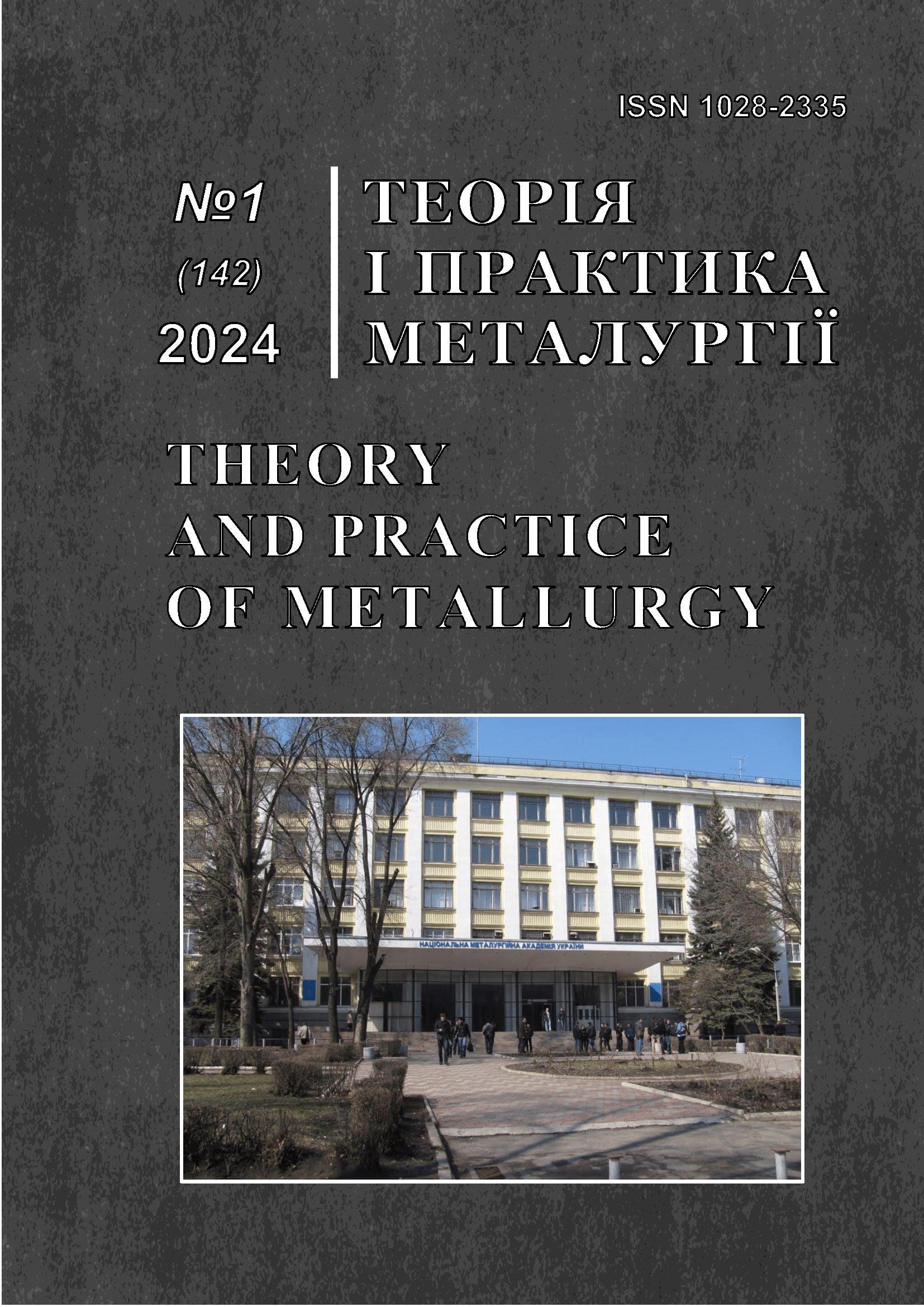Physico-chemical justification and experimental verification of a waste-free method of oxidative dephosphorization of a high-phosphorus manganese alloy
DOI:
https://doi.org/10.15802/tpm.1.2024.01Keywords:
electrometallurgical dephosphorization of manganese concentrate, low-phosphorus manganese slag, high-phosphorus manganese ligature, oxygen, air, oxygen converter, blowingAbstract
The purpose of the study: physicochemical justification of the process conditions and development of a rational algorithm for a single-stage waste-free method of oxidative dephosphorization of a high-phosphorus manganese alloy. Methods: thermodynamic analysis of the main reactions during oxidative refining of manganese alloys with a high phosphorus content. Experimental verification of the main stages of refining. Results: The physicochemical essence of the refining process of a high-phosphorus manganese alloy, which consists in creating conditions for oxidation in the alloy of manganese, carbon and silicon, is considered. The thermodynamic forecast of the course of reactions under the given conditions of oxidative refining of the associated metal confirms the possibility of obtaining three products: low-phosphorus manganese slag, ferric melt and phosphorus-containing slag with a phosphorus oxide content of 18-20% (phosphorus fertilizer). Scientific novelty: Based on the results of high-temperature mathematical modeling, it was established that the most rational oxygen consumption, which ensures the achievement of the tasks, is ~ 13 m3. As an oxidant, it is advisable to use oxygen blown by air, which is introduced into the converter bath using an inflatable nozzle from above. In this case, the total air consumption per 100 kg of alloy should be about 50 m3. Practical value: In the work, based on the thermodynamic forecast of the behavior of the elements of the accompanying alloy in oxidizing conditions, assessment of the thermal side of the process and further experimental verification, results were obtained that confirm the possibility of creating a waste-free technological scheme for refining a high-phosphorus alloy. In this case, it is advisable to carry out the refining of the alloy in conditions close to the conditions of modern production of low-phosphorus manganese slag, in which the temperature of the accompanying alloy is 1320...1350°C.
References
Mianovska, Ya. V., Proidak, Yu. S., Kamkina, L. V., Mishalkin, A. P., & Hryshchenko, Yu. N. (2017). Sposib defosforatsii ridkoho vuhletsevoho feromarhantsiu z pidvyshchenym vmistom kremniiu. (Patent No. 114147). Ukrpatent, Biul. No. 8.
Armstrong, F. A. (2008). Why did Nature choose manganese to make oxygen? Philos Trans R Soc Lond B Biol Sci., 363, 1263–1270. https://doi.org/10.1098/rstb.2007.2223
Pecoraro, V. L., Baldwin, M. J., & Gelasco, A. (1994). Interaction of Manganese with Dioxygen and Its Reduced Derivatives. Chem. Rev., 94(3), 807-826. https://doi.org/10.1021/cr00027a012
Post, J.E. (1999). Manganese oxide minerals: Crystal structures and economic and environmental significance. Proc. Natl. Acad. Sci. USA, 96, 3447–3454. https://doi.org/10.1073/pnas.96.7.3447
Augustin, M., Fenske, D., Bardenhagen, I., Westphal, A., Knipper, M., Plaggenborg, T., Kolny-Olesiak, J., & Parisi, J. (2015). Manganese oxide phases and morphologies: A study on calcination temperature and atmospheric dependence. Beilstein J Nanotechnol, 6, 47–59. https://doi.org/10.3762/bjnano.6.6
Chaput, D. L., Fowler, A. J., Seo, O., Duhn, K., Hansel, C. M., & Santelli, C. M. (2019). Mn oxide formation by phototrophs: Spatial and temporal patterns, with evidence of an enzymatic superoxide-mediated pathway. Sci Rep., 9, 18244. https://doi.org/10.1038/s41598-019-54403-8
Hasyk, M. Y. (1992). Marhanets. Metallurhyia
Hasyk, M. Y., Horbachev, V.F., & Khytryk, S.Y. (1972). Fosfor v nykopolskykh marhantsevykh rudakh y eho povedenye pry vyplavke marhantsevykh ferrosplavov. Yzv. vuzov. Chernaia metallurhyia, (8), 69-75.
Shin, D.J., Gao, X., Ueda, S., & Kitamura, S.-Y. (2019). Selective Reduction of Phosphorus from Manganese Ore to Produce Ferromanganese Alloy with Low Phosphorus Content. Journal of Sustainable Metallurgy, 5(3), 362-377. https://doi.org/10.1007/s40831-019-00227-9
Xi, X., Yang, S., Li, J., Luo, D., Cai, X., & Lai, C. (2019). Phosphorus distribution between rare earth oxides containing slags and ferromanganese alloy. Ironmaking and Steelmaking, 46(5), 485-490. https://doi.org/10.1080/03019233.2017.1405151
Kim, D.-Y., Kim, H.-S., & Jung, S.-M. (2016). Production of (Mn,Fe)-carbide containing low phosphorus by carbothermic reduction of Mn oxide and Fe oxide. Engineering Solutions for Sustainability: Materials and Resources II, 73-83. https://doi.org/10.1007/978-3-319-48138-8_6
Liakyshev, N. P. (Ed.) (1997). Dyahrammy sostoianyia dvoinykh metallycheskykh system. Vol. 2. Mashynostroenye, 509-510
Lee, Y. E. (1986). Thermodynamics of the Mn-P system. Metallurgical Transactions B, 17(4), 777-783. https://doi.org/10.1007/BF02657140
Bale, C. W., Bélisle, E., Chartrand, P., Decterov, S. A., Eriksson, G., Hack, K., Jung, I.-H., Kang, Y.-B., Melançon, J., Pelton, A. D., Robelin, C., & Petersen S. (2009). FactSage thermochemical software and databases - recent developments. Computer Coupling of Phase Diagrams and Thermochemistry, 33(2), 295-311. https://doi.org/10.1016/j.calphad.2008.09.009.
Xi, X., Yang, S., Li, J., Luo, D., Cai, X., & Lai, C. (2019). Phosphorus distribution between rare earth oxides containing slags and ferromanganese alloy. Ironmaking and Steelmaking, 46(5), 485-490. https://doi.org/10.1080/03019233.2017.1405151
Masaki, F., Hiroyuki, K., Akira, Y., & Michitaka, M. (1988). Dephosphorization OF Fe-Mn-C alloy with BaCO3. Tetsu-To-Hagane/Journal of the Iron and Steel Institute of Japan, 74(5), 816-822. https://doi.org/10.2355/tetsutohagane1955.74.5_816
Joo, S.-W., Hong, S.-H., Lee, G.-H., & You, B.-D. (2013). Evaporation behavior of low carbon ferromanganese alloy melt at reduced pressure. Metals and Materials International, 19(3), 585-590. https://doi.org/10.1007/s12540-013-3030-x
Hasyk, M. Y., & Liakyshev, N. P. (1999). Teoryia y tekhnolohyia elektrometallurhyy ferrosplavov. SP Yntermet Ynzhynyrynh
Ellyot, D.F., Hleizer, M., & Ramakryshna, V. (1969). Termokhymyia staleplavylnykh protsessov. Metallurhyia
Rozenhart, Yu. Y., Yakobson, B.Y., & Muradova, Z. A. (1988). Vtorychnye enerhetycheskye resursy chernoi metallurhyy y ykh yspolzovanye. Vyshcha shkola
Downloads
Published
How to Cite
Issue
Section
License
Copyright (c) 2024 Kamkina L.V., Velychko K.O., Velychko O.G., Jiang Zhouhua

This work is licensed under a Creative Commons Attribution 4.0 International License.
Authors retain copyright of the published papers and grant to the publisher the non-exclusive right to publish the article, to be cited as its original publisher in case of reuse, and to distribute it in all forms and media. Articles will be distributed under the Creative Commons Attribution 4.0 International (CC BY 4.0) licence.
Authors can enter the separate, additional contractual arrangements for non-exclusive distribution of the published paper (e.g., post it to an institutional repository or publish it in a book), with an acknowledgement of its initial publication in this journal.




